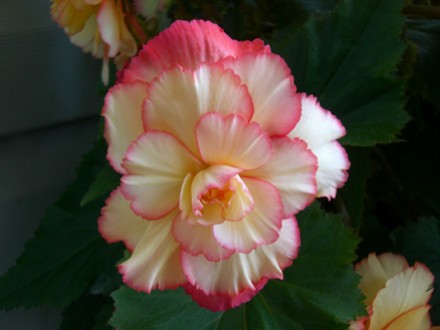Begonia BulbTime
By Jos Van Hage

Tuberous Begonias come in a wide variety of shades and styles
There are not many shade loving outdoor plants that can rival the beauty of the flower found on the tuberous begonia.
These flowers come in a wide range of color, type, and size, with some of them spanning 4-6 inches across. The plants become available in the garden center in the spring but right now you can purchase the tubers which are how they are most commonly propagated.
The nice thing about starting your own tubers is that the selection of different varieties is much larger in tubers than in the plants and it is much more cost efficient. Tubers are started in early February so that by May the plants are large and in bloom.
Start by choosing a large (the larger the tuber the larger the plant will be), firm, healthy tuber that has no signs of soft spots or rot. Also pick up some 4 inch peat pots and some good quality, light, airy, good draining potting soil to plant the tuber into.
To plant the tuber first fill the peat pots to within an inch from the top with the soil and then next place the tuber into the soil and then cover the tuber with no more than ½ an inch of soil. Make sure that the tuber is right side up by having the hollow side of the tuber facing up. After placing the tuber in the soil, water the soil that is surrounding the tuber being careful not to get water directly into the hollow of the tuber as this can cause the tuber to rot. The next step would be to place the planted tuber in a windowsill or under a fluorescent light where the temperature is 17-20 Celsius.
To help promote growth, cover the pot with either plastic or a plastic dome and as soon as growth appears (anywhere from 10 days to 5 weeks) the plastic or dome is removed. Continue to give the plant as much light as possible but keep it out of direct midday sun as tuberous begonias are a shade loving plant. Also keep the soil moist, but not soggy and fertilize with 10-52-10 which is a plant start fertilizer.
Once plants have become 3-4 inches in height they can be transplanted into larger containers.
If you chose to start the tuberous begonias in a peat pot then the entire pot is planted with the plant inside resulting in little to no root disturbance. For the plant to grow strong and stocky it should be kept in a cooler location. Continue to give it lots of light and if it is in a window sill turn the plant every few days so that it does not grow towards one side.
Tuberous begonias cannot take any frost at all so be careful when you are ready to bring the plant outdoors, making sure that all threat of frost has passed. Choose an area where it will receive either early morning or late afternoon sun as they do best in a semi-shaded area.
Tuberous begonias are beautiful in containers and make attractive hanging baskets either on their own or mixed with impatiens, lobelia or fuchsias. At the Art Knapp west location we plant 6-8 shade baskets filled with tuberous begonias, silver nettle and lobelia and hang them along the shady side of the building where they do very well throughout the summer months.
A very important key to growing tuberous begonias successfully is to be careful not to get water on the foliage. Always water directly on the soil surrounding the plant or let the plant soak it up from the bottom and do not keep them too wet. Also make sure that there is enough air circulation, and that all finished blooms and any broken or damaged foliage is removed to prevent mold and fungus which is damaging to the plant.
In the fall after the first frost the tuberous begonias are brought indoors and can be saved by following a few simple steps and then replanted again next February to be enjoyed for yet another year making it a good investment for the garden.
- Highway 16 West at Kimball Road
- Highway 97 North at Northwood Pulpmill Road
Previous Story - Next Story
Return to Home









